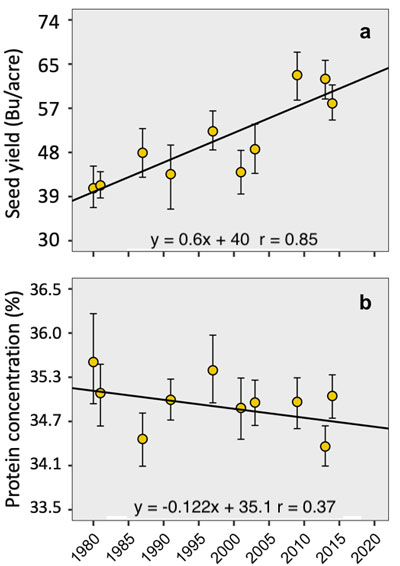Two K-State Research and Extension publications dealing with soybean production have been released online. The first is the Kansas Soybean Management (MF3154) revised for 2021. Each publication is discussed briefly below with links.

This publication offers advice to producers, crop consultants, and agronomists to help manage Kansas soybean crops as efficiently and profitably as possible. Recommendations provide guidelines and must be tailored to the diverse conditions found in cropping systems across the state.
Visit the KSRE Bookstore to view and download this publication: https://bookstore.ksre.ksu.edu/pubs/MF3154.pdf
This comprehensive guide is written specifically for Kansas and includes valuable, up-to-date information on:
- Tillage and rotations
- Variety selection
- Planting practices
- Trend on yield and seed protein concentration over time
- Seed quality management and potential uses
- Tillering (New section for 2021)
- Weed management
- Fertilizer requirements
- Diseases
- Insects
- Irrigation
Contributors to the 2021 version of this publication include:
Ignacio Ciampitti, Crop Production and Cropping Systems
Andre Froes De Borja Reis, Crop Production and Cropping Systems
Sarah Lancaster, Weed Management
Dorivar Ruiz Diaz, Soil Fertility and Nutrient Management
Jonathan Aguilar, Bio and Ag Engineering – Irrigation
Doug Jardine, Plant Pathology
Rodrigo Onofre, Plant Pathology
Stu Duncan, Area Agronomist
Jeff Whitworth, Entomology
The second is a brand new publication, Soybean Seed Composition: Changes in Protein and Amino Acids Over Four Decades (MF3552).

Soybeans are a major protein source and provide 70% of global plant-based protein meal for animal feed. Soybean meal quality is defined by seed protein concentration and the relative composition of essential and nonessential amino acids. Many years of breeding efforts have increased soybean yield potential. However, yield improvements have been linked to a reduction of seed protein concentration (Figure 1).

Figure 1. Relationship between seed yield (a) or protein concentration (b) with the year of release of varieties from 1980 to 2014. From MF3552, Ciampitti et al., 2021)
This publication discusses how soybean varieties released over the last four decades have displayed a yield increase linked to a reduction in protein concentration and why future progress in yield should not overlook seed nutritional value (see below figure, relationship for yield and protein concentration over the last four decades).
This publication is available online at: https://bookstore.ksre.ksu.edu/pubs/MF3552.pdf
Ignacio Ciampitti, Farming Systems, K-State Agronomy Dept.
ciampitti@ksu.edu
Seth Naeve, Soybean Agronomist – University of Minnesota
Andre F.B. Reis, Post-doctoral researcher – K-State Agronomy Dept.
Luiz Rosso, Graduate student – K-State Agronomy Dept.
Tags: soybeans publication